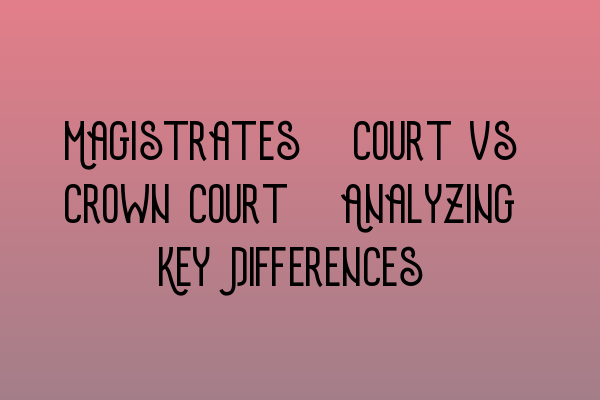Magistrates’ Court vs Crown Court: Analyzing Key Differences
Welcome to the SQE Criminal Law & Practice Law UK blog! In today’s article, we will be examining the significant differences between Magistrates’ Court and Crown Court in the UK criminal justice system.
Understanding the Hierarchical Structure
Before delving into the disparities between Magistrates’ Court and Crown Court, it’s essential to grasp the hierarchical structure of the UK courts system. The Magistrates’ Court serves as the lower-tier court, dealing with less serious criminal cases, while the Crown Court acts as the higher-tier court, handling more severe and complex criminal matters.
To pass the SQE 1 examination, it’s crucial to have a deep understanding of the differences between these two courts. If you’re preparing for the SQE 1 examination, make sure to check out our SQE 1 Practice Exam Questions and SQE 1 Practice Mocks FLK1 FLK2 to enhance your knowledge and skills!
Key Differences: Magistrates’ Court
The Magistrates’ Court operates under the guidance of a panel of magistrates or a district judge. Here are a few key characteristics of the Magistrates’ Court:
- Handles less serious offenses, such as minor traffic offenses, petty theft, and low-value criminal damage cases.
- Decides on guilt or innocence, as well as sentencing for most cases.
- Does not have a jury, with the decision-making responsibility solely resting on the magistrates or district judge.
- Proceedings are relatively informal, and the court follows a less complex procedural process.
If you’re looking for comprehensive SQE 2 preparation courses, check out our SQE 2 Preparation Courses to equip yourself with the knowledge and skills required for success!
Key Differences: Crown Court
The Crown Court, on the other hand, deals with more serious criminal cases and has its own unique features:
- Handles indictable offenses, which are offenses that require a trial by jury, such as murder, rape, and serious fraud.
- Decides on guilt or innocence, but for certain cases, the sentencing is passed to a higher court, such as the High Court.
- Proceedings are more formal, and the court follows a complex procedural process.
- Consists of a jury comprising 12 members who reach a verdict based on the evidence presented during the trial.
For individuals preparing for the SQE 1 examination, our SQE 1 Preparation Courses offer comprehensive study materials and expert guidance to help you succeed in your undertakings!
In Conclusion
Understanding the key differences between Magistrates’ Court and Crown Court is essential in criminal law practice. Aspiring solicitors should be well-versed in the distinct characteristics and procedures of each court to provide effective legal representation.
For further information about the SRA SQE exam dates and other important details, please refer to our dedicated article on SRA SQE Exam Dates.
We hope this article has shed light on the significant disparities between Magistrates’ Court and Crown Court. To further enhance your knowledge and prepare for the SQE examinations, we recommend exploring our wide range of preparation materials and courses.
Stay tuned for more informative articles from SQE Criminal Law & Practice Law UK!
